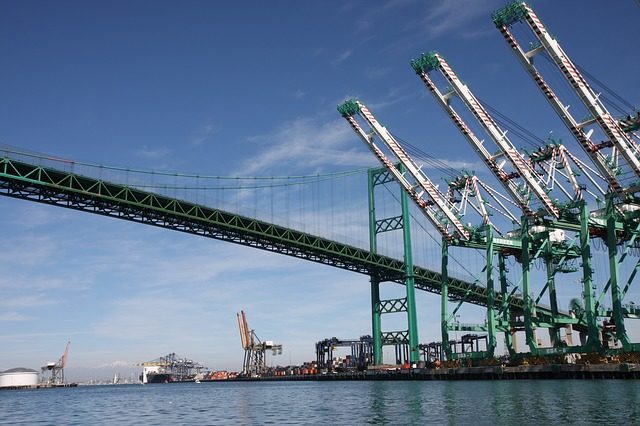Home » West Coast ports to expand operations, tackle bottlenecks
West Coast ports to expand operations, tackle bottlenecks
As government leaders and the private sector attempt to address supply chain problems, industry experts say delays, disruptions will last well into 2022.

Supply chain challenges and product shortages remain in the spotlight, with government and private-sector officials taking steps this week to alleviate the strain on West Coast ports.
Representatives from the Biden administration met Wednesday with officials from the ports of Los Angeles and Long Beach, trade unions, and private companies to address the problems, saying the ports will move toward 24/7 operations to help speed the flow of goods through the Southern California gateways, which serve as the point of entry for 40% of shipping containers to the United States. Both ports took steps in September to expand operating hours, with Long Beach maximizing night operations and Los Angeles expanding weekend operating gate hours, and officials there say they are working with supply chain stakeholders to expand further.
The Port of Los Angeles will host a press conference at 10 a.m. Pacific Time/1 p.m. Eastern Time today to discuss details of the expansion plan.
Industry trade groups applauded the efforts Wednesday, but pointed to a slew of problems plaguing the supply chain, including a labor crisis that has been building throughout the pandemic. In a statement Wednesday, the Consumer Brands Association, which represents the consumer packaged goods industry, said today’s higher prices and supply chain bottlenecks are symptoms of the labor shortage in the United States. Consumer Brands President and CEO Geoff Freeman listed steps to alleviate the problem, including financial incentives for recruiting truck drivers, temporary visas to bring in workers to fill employment gaps, and “if needed, targeted use of the National Guard to relieve significant supply chain congestion.”
“We cannot ignore the warning signals of higher prices and reduced availability,” Freeman said in a press statement. “While our problems will not be solved overnight, with the administration’s engagement we are on a clearer path to tackling the supply chain crisis from every angle.”
The U.S. Chamber of Commerce echoed those sentiments, emphasizing corporate efforts to speed the flow of goods to shelves. Walmart, Target, FedEx, UPS, Samsung, and The Home Depot were among the companies at the White House Meeting Wednesday that have agreed to use the expanded hours on the West Coast to move more cargo off the docks.
“American companies are stepping up to combat the bottlenecks and delays and this will make a crucial difference as we seek to tackle this problem head-on,” Suzanne Clark, U.S. Chamber of Commerce president and CEO, said in a prepared statement. “This supply chain crisis is hurting businesses and consumers alike, leading to inflation and shortages of key supplies. Coupled with massive labor shortages, this is a major threat to our fragile economic recovery and long-term competitiveness.”
The degree to which West Coast port efforts will help alleviate supply chain pressures remains to be seen. In the meantime, other experts say the delays and disruptions caused by tight capacity, rising prices, a lack of labor, and accelerating consumer demand are likely to last well into 2022.
Alan Holland, CEO of intelligent sourcing solutions provider Keelvar, said earlier this month that the problems extend well beyond U.S. borders as shippers struggle with the higher costs of transporting goods. Companies that have strategic sourcing partnerships with transportation providers are in a better position when demand exceeds capacity, he said, leaving transactional buyers—those who typically rely more on spot market rates—at the end of the line. He said bulky goods such as furniture and home furnishings, as well as voluminous, low-value goods such as toys, will be among those in short supply through the holiday season.
“There’s a trust issue here,” Holland explained. “Where companies have decided to invest in partnerships and build mutual trust, those companies are getting their goods moved with greater certainty. Others who were tactical buyers … are suffering.”
Holland says he expects continued volatility beyond peak shipping season.
“[I think] it’s fair to say it will be close to 12 months, if not longer,” before there is any relief in the supply chain, he said. “Ahead of Chinese New Year, there won’t be any change in the situation; we can expect a lot of volatility.”
Zac Rogers, assistant professor of supply chain management at Colorado State University and a researcher for the monthly Logistics Manager’s Index (LMI), agreed, pointing to the high volume of goods moving through the supply chain since the summer of 2020—a situation that shows no signs of abating. The LMI gauges economic activity across the transportation and logistics industry, and has been tracking an extended growth run since the beginning of the pandemic. Consistent high transportation and warehousing costs coupled with tight capacity in both areas indicate a tough road ahead, he said.
“It seems like the supply chain is tired,” Rogers said in mid-September, commenting on the rapid growth in the channel since February of this year, in particular. “[Market conditions] are probably going to be tight for quite a while longer.”
Maritime & Ocean Ports Supply Chain StrategyKEYWORDS Consumer Brands Association LMI - Logistics Managers' Index Port of Long Beach Port of Los Angeles U.S. Chamber of Commerce
Related Articles

Victoria Kickham started her career as a newspaper reporter in the Boston area before moving into B2B journalism. She has covered manufacturing, distribution and supply chain issues for a variety of publications in the industrial and electronics sectors, and now writes about everything from forklift batteries to omnichannel business trends for DC Velocity.
Copyright ©2024. All Rights ReservedDesign, CMS, Hosting & Web Development :: ePublishing